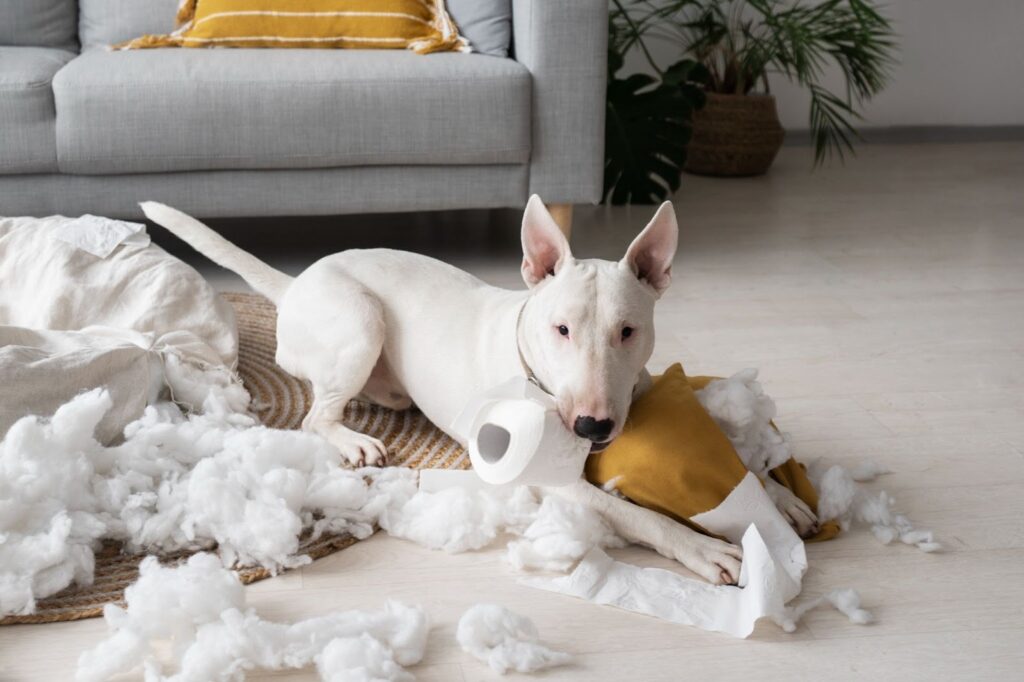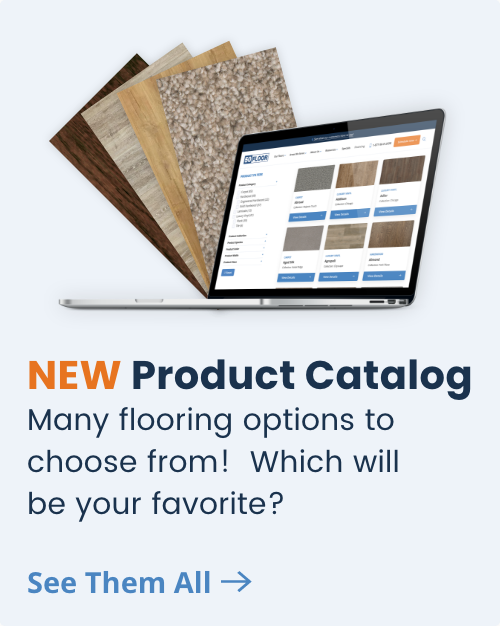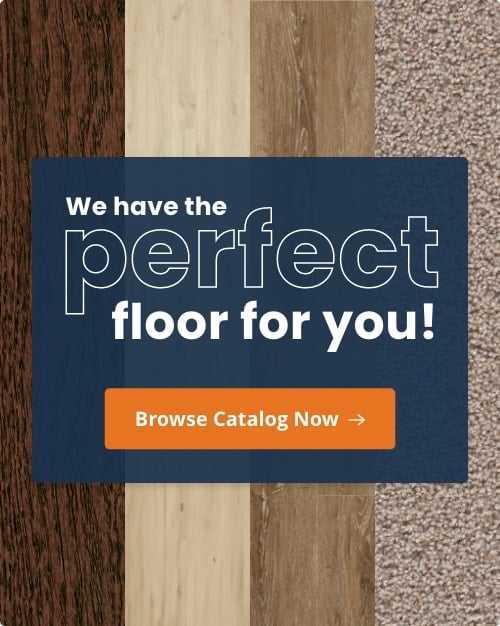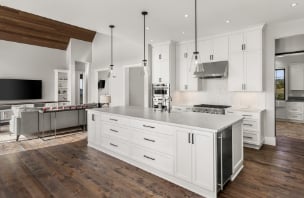

Ever mopped up muddy paw prints… five times in one day? If you live with pets, you already know the battle between clean floors and cute paws never really ends. Between the unexpected puddles, nail scratches, and the trail of fur that somehow appears minutes after vacuuming, your flooring takes a daily beating, and not all materials can keep up.
That’s why more pet owners today are getting smart about what’s underfoot. The goal isn’t just about finding something stylish, it’s about choosing a surface that can handle claws, spills, and zoomies without giving you a headache. The right flooring can save hours of cleanup, reduce odors, and even keep your furry companions more comfortable.
We took a close look at the top five contenders: vinyl, laminate, tile, engineered wood, and carpet, and compared how each performs when pets are part of the picture. You’ll discover which flooring truly endures, which necessitates additional maintenance, and which is undoubtedly a pet owner’s most trusted companion.
Factors to Consider before Buying Flooring:
Before diving into the best options, it helps to know what really matters when picking pet-friendly floors. Here are the top factors to consider:
Scratch Resistance
If you have a large or active dog like a Labrador Retriever, German Shepherd, or Golden Retriever, scratch resistance should be at the top of your list. Their heavier weight and energy levels can quickly wear down softer materials like pine or certain laminates. Even smaller but feisty breeds like Jack Russells or Beagles can leave claw marks during playtime.
But it’s not just dogs. Cats who love to zoom or sharpen their claws, and even rabbits or ferrets with strong hind legs, can leave marks on delicate floors. Look for high-density, durable materials that can handle daily wear and tear, such as vinyl, tile, or textured laminate. Finishes like matte or distressed also do a great job of camouflaging tiny scuffs that shiny floors love to highlight.
Water & Stain Resistance
Even the most well-trained pets have their moments, whether it’s a spilled water bowl, muddy paw prints after rain, or the occasional “oops.” Floors that aren’t water-resistant can warp, swell, or stain over time.
Materials like vinyl and tile are top performers here, while hardwoods and laminate can struggle if moisture seeps through seams. Always choose sealed or waterproof surfaces, and clean up messes as soon as they happen to prevent lingering odors or discoloration.
For households with breeds that shed or slobber more (like Newfoundlands, Bulldogs, or Basset Hounds), vinyl and porcelain tile are lifesavers. They resist both moisture and stains, making cleanup simple and worry-free.
The same applies to homes with cats who occasionally miss the litter box, birds that scatter water, or small animals with bedding messes, sealed surfaces protect you from long-term damage. Always choose sealed materials and avoid porous flooring like unsealed wood.
Ease of Cleaning
If you own a Husky, Golden Retriever, or Corgi, you already know the meaning of constant shedding. Smooth, nonporous surfaces that can be vacuumed or wiped easily, like vinyl or tile, are ideal for keeping fur and dander under control.
On the other hand, if you have low-shedding breeds like Poodles or Maltipoos, you can get away with softer materials such as engineered wood or low-pile carpet tiles. Likewise, short-haired cats, birds, or reptile owners who deal less with shedding can focus more on comfort and style.
Just remember: carpets tend to trap odors and require more frequent deep cleaning, especially in multi-pet homes.
Comfort & Traction
Slippery floors can be tough for pets, especially older dogs or breeds prone to joint issues like Labradors, German Shepherds, or Dachshunds. If your dog struggles to get traction or slips when turning corners, it can lead to hip and joint strain over time.
Go for softer, slip-resistant options like textured vinyl, cork-backed laminate, or low-pile carpet tiles. They provide better grip and cushioning for running, resting, and daily play. Cats and smaller pets also appreciate surfaces that offer warmth and a bit of give under their paws or claws. For caged animals, flooring that reduces vibration and noise makes their environment calmer and less stressful.
Temperature & Noise Control
Different flooring types affect how your home feels and sounds. Tile and stone can stay cold and echoey, which might bother smaller or short-haired dogs like Chihuahuas or Greyhounds, especially in cooler climates. Meanwhile, hardwood and vinyl tend to absorb sound better, helping minimize that constant click-clack of paws on the floor.
If you live in a warm area or have fluffy breeds like Samoyeds or Huskies, cooler surfaces like tile can actually be a plus. Cats often prefer warmer, softer areas, so pair cool flooring with cozy rugs or heated pet mats. The key is to balance temperature and noise so both you and your pets, whether they bark, purr, or chirp, stay comfortable.
Cost & Longevity
Finally, think long-term. Cheap flooring might seem like a win upfront, but constant repairs or early replacements can quickly eat into your savings. Investing in a durable, pet-tough surface pays off in the long run with fewer scratches, less maintenance, and a better-looking home over time. Look for products with strong warranties and proven resistance to both pets and heavy foot traffic.
And remember: longevity isn’t just about durability. Some pets, like birds and small mammals, are sensitive to fumes, so investing in low-VOC, non-toxic flooring ensures a safer environment for them and for you.
Top Materials for Pet-Friendly Flooring
Before diving into the nitty-gritty details, here’s a quick glance at how the most popular flooring types stack up for pet owners. Think of it as your cheat sheet before we unpack which ones truly earn their “pet-proof” badge.
| Flooring Type | Scratch Resistance | Stain Resistance | Comfort | Cost | Pet-Friendliness Score |
| Vinyl | ✅✅✅ | ✅✅✅ | ✅✅ | 💲 | ⭐⭐⭐⭐☆ |
| Laminate | ✅✅ | ✅✅ | ✅ | 💲 | ⭐⭐⭐☆☆ |
| Tile | ✅✅✅✅ | ✅✅✅ | ✅ | 💲💲 | ⭐⭐⭐⭐☆ |
| Engineered Wood | ✅✅ | ✅✅ | ✅✅✅ | 💲💲💲 | ⭐⭐⭐⭐☆ |
| Carpet | ❌ | ❌ | ✅✅✅✅ | 💲💲 | ⭐⭐☆☆☆ |
Vinyl Flooring
Best for: Households with multiple pets, large dogs, or frequent messes (think Labradors, Beagles, or cats that love knocking over water bowls).
Vinyl remains the gold standard for pet owners this year. It checks nearly every box: scratch-resistant, waterproof, budget-friendly, and stylish.
Thanks to modern upgrades like luxury vinyl planks (LVP) and stone plastic composite (SPC) cores, this material can mimic the look of real hardwood or stone while standing up to everything from muddy paws to toppled water bowls.
It’s also softer and warmer underfoot than tile, making it a comfortable option for pets who love lounging on the floor. For households with multiple animals vinyl delivers a reliable balance between resilience and comfort.
Why it works for pet owners:
- 100% waterproof and stain-resistant
- Holds up against scratches and scuffs from active dogs and cats
- Soft, quiet, and warm underfoot, making it ideal for multi-pet homes or upstairs units
- Budget-friendly with lots of realistic textures and finishes
Things to note:
- Can dent under heavy furniture or sharp objects
- Some cheaper versions can fade or peel over time
Laminate Flooring: Budget-Friendly, but Handle with Care
Best for: Smaller pets or low-traffic homes with well-trained animals (Poodles, Cocker Spaniels, or cats that prefer lounging over leaping).
Laminate is a solid middle-ground choice; it offers the look of wood without the high price tag. Newer waterproof and scratch-resistant laminates have made it a go-to for pet owners on a budget.
However, keep in mind that not all laminates handle moisture equally well. If you have multiple pets or frequent spills, go for waterproof-rated laminate or install it in low-moisture rooms like bedrooms and living areas.
Why it works:
- Affordable and easy to install
- Scratch-resistant coatings available in newer designs
- Comes in a wide variety of styles and textures
Watch out for:
- Struggles with water exposure. A spilled water bowl or pet accident left unattended can seep into seams and cause swelling.
- Can be slippery for dogs, especially older ones
Tile Flooring: The Toughest of Them All
Best for: Big breeds, messy pets, or homes in hot areas (Huskies, Labradors, or outdoor-loving pets).
If toughness is your top priority, tile is the undisputed heavyweight champion. Porcelain and ceramic tiles are nearly impervious to scratches, moisture, and odors. They’re a dream for homes with large or active pets who run, play, or track in dirt daily.
Why it works:
- Handles mud, claws, and accidents with ease.
- Naturally resists allergens and odors.
- Super easy to disinfect, so perfect for households with multiple animals.
- Lasts for decades with minimal wear.
Considerations:
- Hard and cold underfoot so not the coziest for naps
- Slippery when wet unless textured
- Requires grout cleaning to prevent buildup
Engineered Wood: Real Wood Look, Pet-Ready Performance
Best for: Pet owners who want that natural wood feel and have manageable pets (small to medium pets; owners who love real wood looks).
For those who crave the timeless beauty of real wood, engineered wood flooring is the pet-friendly compromise you’ve been looking for. It offers the warmth and elegance of solid hardwood, but with improved stability and moisture resistance thanks to its layered construction.
While not completely immune to scratches or water damage, newer finishes and sealants make it far more resilient than traditional hardwood. It’s a great choice for households with calmer pets or where you want style to take center stage.
Why it works:
- Real-wood top gives warmth and natural beauty.
- More stable than solid hardwood in humid or pet-active homes.
- Available with scratch-resistant finishes (look for aluminum oxide coatings).
Keep in mind:
- Still susceptible to deep claw marks
- Not fully waterproof spill must be cleaned quickly
- Higher upfront cost
Carpet: Comfort King, But High Maintenance
Best for: Small pets or older animals who need softness underfoot (Shih Tzus, senior cats, or less active breeds).
Carpets might be your pet’s favorite surface, but it’s also the most demanding to maintain. It traps fur, dander, and odors easily. However, newer carpet tiles and low-pile synthetics can make cleanup more manageable.
Plus, each tile can be lifted and replaced individually, perfect for cleaning up accidents or refreshing worn areas. For cats, dogs, and even caged pets that spend time exploring, this flooring creates a cozy, quiet environment that feels more like home.
Why it works:
- Comfortable for lounging and joint support
- Quiets noise from running paws
- Modern options resist stains and odors
Downsides:
- Traps hair, dander, and smells
- Harder to clean after accidents
- May need regular deep cleaning
Alternative Pet-Friendly Flooring Options
If the main five options don’t quite match your home’s look or lifestyle, there are several modern and eco-friendly alternatives that deserve attention. These materials combine durability, comfort, and practicality which are perfect for homes shared with dogs, cats, rabbits, birds, or even free-roaming small pets.
Cork Flooring
Cork is a hidden gem for pet owners. It’s naturally antimicrobial, helping to reduce allergens, odors, and bacteria which is a major plus if you have cats or small pets that roam freely. Its warm, cushioned surface is gentle on paws and joints, making it especially comfortable for older animals or pets who love to sprawl out.
However, cork is somewhat sensitive to moisture and sharp claws, so regular sealing and trimming your pet’s nails will help maintain its appearance.
Bamboo Flooring
Bamboo offers the beauty of hardwood without the same vulnerability. It’s denser and more scratch-resistant than most traditional wood types, making it suitable for medium to large pets, including active cats who like to climb and jump.
Bamboo is also renewable and eco-conscious which makes it a great choice for pet owners who want sustainability without compromising style. Just keep in mind that like hardwood, it can be prone to water damage if spills aren’t cleaned promptly.
Rubber Flooring
While not typically seen in living rooms, rubber flooring is a surprisingly pet-friendly option for certain areas. It’s durable, water-resistant, and incredibly shock-absorbent, which means fewer slips and softer landings for energetic or older pets.
It also helps reduce noise from claws and movement which is a blessing in multi-pet households or apartment settings. Rubber flooring works especially well in basements, playrooms, home gyms, or pet zones where durability and comfort matter more than aesthetics.
Other Considerations
If you’re experimenting with newer materials, linoleum and sealed concrete are worth a look too. Linoleum is eco-friendly, resistant to moisture, and easy to clean which is great for households with birds or small animals.
Sealed concrete, on the other hand, offers unmatched durability and cooling benefits, ideal for hot climates or homes with big, active pets. Adding area rugs or mats can make these harder surfaces more comfortable without sacrificing practicality.
Maintenance & Cleaning Hacks for Pet-Friendly Floors
Keeping your floors clean when you share your home with pets isn’t about perfection, it’s about building small, realistic habits that make life easier. The good news? With a few smart tricks, you can keep your space looking fresh and fur-free without spending every weekend scrubbing.
1. Use Area Rugs in High-Traffic Zones
Entryways, hallways, and the spot where your pet always waits for you to come home take the most abuse. Laying down washable rugs or runners is an easy way to catch dirt, fur, and moisture before it spreads through the house.
Opt for rugs with rubber or non-slip backing to prevent sliding (especially if you have older pets), and choose darker or patterned designs to disguise stains between washes. Bonus: pets love lounging on them, so it’s a win for comfort, too.
2. Trim Your Pet’s Nails Regularly
A simple nail trim can go a long way toward protecting your floors. Long claws act like tiny chisels, especially on vinyl, laminate, and hardwood. For pets who hate nail clippers, try grinders or scratch boards as they’re easier on both of you and help keep nails smooth.
If you hear your pet’s nails clicking on the floor, it’s a sign they’re due for a trim. Regular maintenance keeps your floors glossy longer and makes walking more comfortable for your furry friends.
3. Use pH-Neutral Cleaners
It’s tempting to grab vinegar for every cleaning job, but here’s the truth: it can dull finishes and damage sealants on wood and vinyl floors. Stick to pH-balanced or pet-safe cleaners made specifically for your flooring type. They’re gentle, effective, and won’t leave behind strong odors that bother sensitive noses.
For a quick DIY option, mix a few drops of mild dish soap in warm water. It’s safe for most sealed surfaces and still cuts through dirt and paw prints with ease.
4. Wipe Spills Immediately
Even the best-behaved pets have accidents. The trick is to catch it fast. Wiping spills right away prevents moisture from seeping into cracks, swelling boards, or leaving behind stubborn odors.
Keep microfiber cloths, pet-safe wipes, or a spray bottle handy in key spots around the house. A quick wipe now saves you hours of scrubbing later.
5. Invest in a Robot Vacuum with Pet-Hair Sensors
If you’re constantly sweeping up fur, a robot vacuum might be the best investment you’ll ever make. Models designed for pet households have tangle-free brushes, strong suction, and hair-detection sensors that automatically adjust cleaning power when they detect heavy shedding.
Run it once or twice a day, even while you’re out, and your floors will stay noticeably cleaner with almost no effort. It’s also a great way to reduce allergens and keep your air fresher, especially if you live with multiple pets or long-haired breeds.
6. Create a “Pet Cleaning Station”
Set up a small corner near your entryway with towels, wipes, a paw washer, and a small waste bin. Wipe paws before your pet comes inside, and you’ll instantly cut down on muddy prints and wet spots, especially during the rainy season.
The Bottom Line
Your pets deserve floors that feel as good as they look , and you deserve a home that’s easy to clean and maintain. Whether you’re going for style, comfort, or pure practicality, the right flooring can make all the difference in keeping tails wagging (and floors shining).
For expert help choosing the best fit for your home and lifestyle, and to explore durable, pet-friendly feel free to explore our flooring options installed by professionals who understand what both your and your pets need.
FAQs: Quick Answers for Curious Pet Owners
- Is SPC flooring pet-friendly?
Yes, SPC (Stone Plastic Composite) flooring is an excellent choice for homes with pets. It combines the durability of stone with the flexibility of vinyl, making it resistant to scratches, stains, and water. Its rigid core can handle heavy claws, zoomies, and even the occasional spill without warping or denting.
Plus, it’s easy to clean and doesn’t trap pet hair or dander, which is great for allergy management. The only downside is that it can feel a bit cold or hard underfoot, so adding area rugs can help make it cozier for your furry companions.
- What’s the quietest flooring for cats?
If you live with cats, you’ll want a flooring material that minimizes the sound of paws, especially during those 3 A.M. sprints. Carpet tiles and cork flooring are the quietest options, thanks to their soft, sound-absorbing texture.
Vinyl is also a good middle ground: it reduces noise while remaining easy to clean. Avoid harder materials like tile or traditional hardwood, as they tend to amplify the tapping of claws and movement across the surface.
- Can I use steam cleaners on vinyl flooring?
It’s best to avoid using steam cleaners on vinyl floors. The high heat and moisture can weaken the adhesive layer or cause the planks to warp over time. Instead, stick to a pH-neutral cleaner and a damp microfiber mop for regular maintenance.
For deeper cleaning, use warm water mixed with a few drops of mild detergent, just make sure not to oversaturate the floor. This keeps your vinyl looking fresh and extends its lifespan without risking damage.



